Toshiba Portege G900, G900 User Guide


Table of contents
Network services 5
Toshiba Corporation 6
EU Warranty 9
Licenses 10
Declaration of conformity 12
Health and safety 13
General 13
Operating environment 14 Electronic devices 15 Battery safety 15
AC adapter and cable safety 16 Emergency calls 17
Wireless LAN security 17 Bluetooth security 17 FCC notice 18 Information to user 18
FCC RF exposure information 19 European RF Exposure Information 20
Care and maintenance 22 |
contents |
|
|
||
Care and maintenance 22 |
of |
|
Restarting your Toshiba phone 23 |
||
Table |
||
Resetting your Toshiba phone 23 |
||
Reinitialising your Toshiba phone 24 |
||
|
||
Getting started 25 |
|
|
Unpacking 25 |
|
|
Phone layout and functions |
|
|
26 |
|
|
Today screen 29 |
|
|
Start menu 30 |
|
|
Display indicators 31 |
|
|
Installing the SIM card, battery and |
|
|
miniSD card 34 |
|
|
Removing and reinserting the stylus 37 |
|
|
Using the stylus 37 |
|
|
Charging the battery 38 |
|
|
Switching the power on and off 39 |
|
|
Synchronising 40 |
|
|
Using the USB Host cable 41 |
|
|
|
1 |

contents |
Table of contents |
|
Call functions 42 |
||
|
||
of |
Making a call 42 |
|
Receiving a call 44 |
||
Table |
||
In-call options 45 |
||
Special dialling requirements 46 |
||
|
Video telephony 47 |
|
|
Messaging 48 |
|
|
Messaging options 48 |
|
|
Text (SMS) messaging 49 |
|
|
E-mail 51 |
|
|
MMS messaging 56 |
|
|
Windows Live Messenger 59 |
|
|
Text input 61 |
|
|
Input methods 61 |
|
|
Block Recognizer 61 |
|
|
Keyboard 62 |
|
|
Letter Recognizer 62 |
|
|
Transcriber 63 |
|
|
XT9 68 |
|
|
Drawing and writing on the screen 68 |
|
2 |
|
Searching 69
Settings 71
Volume control 71
Reassigning button functions 71 Setting the input method 72 Security settings 72 Customising your Start menu 75 Owner information 75
Phone settings 75
Sounds and notifications 79 Customising your Today screen 80 Video call settings 81
Viewing the About details 82 Backlight settings 82 Viewing certificate details 83 Clock & alarm settings 83
Customer feedback settings 84 Setting storage card encryption 85 Error Reporting 85
Setting up external GPS 86 Master Clear 86

Table of contents
Memory management settings 87 Power management settings 87 Regional settings 88
Removing Programs 88 Screen settings 88 Windows Update 89
Connectivity 90
Connecting to the Internet 90 Bluetooth 93
Beams 96
Checking for a Wireless LAN signal 97 Wireless Manager 98
USB to PC connection 98 USB mass storage 98
Applications & multimedia 99
Office Mobile 99 Calendar 101 Contacts 103 Internet Explorer 106 Messaging 108
Phone 109 |
contents |
Help 109 |
of |
Games 109 |
|
ActiveSync 109 |
Table |
Calculator 109 |
|
Camera 110 |
|
File Explorer 112 |
|
Fingerprint Launcher 113 |
|
GoldKey 114 |
|
Internet Sharing 115 |
|
Java 115 |
|
Messenger 116 |
|
Notes 116 |
|
Opera Browser 117 |
|
Picsel Viewer 118 |
|
Pictures & Videos 118 |
|
Search 120 |
|
SIM Manager 120 |
|
SIM Toolkit 121 |
|
Tasks 121 |
|
Teleport 122 |
|
TIPtalk 124 |
|
|
3 |

contents |
Table of contents |
Windows Live 127 |
|
of |
Windows Media Player 128 |
Zoom 132 |
|
Table |
Specifications 134 |
|
|
|
Troubleshooting 137 |
|
Purchase record 138 |
|
Menu tree 139 |
|
Index 141 |
4 |
|

Network services |
services |
in your Toshiba phone depend on features in the wireless network to function. These network services may |
|
To use your Toshiba phone, you must have service from a wireless service provider. Many of the features |
|
not be available on all networks, or you may have to make specific arrangements with your service provider |
Network |
before you can utilise network services. Your service provider may need to give you additional instructions |
|
for their use and explain what charges will apply. Some networks may have limitations that affect how you |
|
can use network services. For instance, some networks may not support all language-dependent |
|
characters and services. |
|
This phone is a 3GPP GSM Release 99 terminal supporting GPRS service, and is designed to also support |
|
Release 97 GPRS networks. However, there may be some compatibility issues when using this phone in |
|
some Release 97 GPRS networks. For more information, contact your service provider. |
|
The availability of particular products may vary by region. Please check with the dealer nearest to you. |
|
|
5 |

Corporation |
Toshiba Corporation |
IMPORTANT NOTE: PLEASE READ BEFORE |
|
|
USING YOUR MOBILE PHONE AS ATTEMPTING |
|
TO USE ANY SOFTWARE ON THE SUPPLIED |
Toshiba |
PHONE CONSTITUTES YOUR ACCEPTANCE OF |
THESE EULA TERMS. IF YOU REJECT OR DO |
|
OR USE THE SUPPLIED SOFTWARE. |
|
|
NOT AGREE WITH ALL THE TERMS OF THIS |
|
EULA, PLEASE DO NOT ATTEMPT TO ACCESS |
|
End User License Agreement |
|
This End User License Agreement ("EULA") is a |
|
legal agreement between you (as the user) and |
|
TOSHIBA CORPORATION ("Toshiba") with regard |
|
to the copyrighted software installed in a Toshiba 3G |
|
mobile phone supplied to you (the "Phone"). |
|
Use or employment of any software installed in the |
|
Phone and related documentations (the "Software") |
|
will constitute your acceptance of these terms, |
|
unless separate terms are provided by the Software |
|
supplier on the Phone, in which case certain |
|
additional or different terms may apply. If you do not |
|
agree with the terms of this EULA, do not use or |
|
employ the Software. |
6 |
|
1.License Grant. Toshiba grants to you a personal, non-transferable and non-exclusive right to use the Software as set out in this EULA. Modifying, adapting, translating, renting, copying, making available, transferring or assigning all or part of the Software, or any rights granted hereunder, to any other persons, and removing any proprietary notices, labels or marks from the Software is strictly prohibited, except as expressly permitted in this EULA. Furthermore, you hereby agree not to create derivative works based on the Software.
2.Copyright. The Software is licensed, not sold. You acknowledge that no title to the intellectual property in the Software is or will be transferred to you. You further acknowledge that title and full ownership rights to the Software will remain the exclusive property of Toshiba, Toshiba's affiliates, and/or their suppliers, and you will not acquire any rights to the Software, except as expressly set out in this EULA. You may keep a backup copy of the Software only so far as necessary for its lawful use. All copies of the Software must contain the same proprietary notices as contained in the Software and are subject to the terms of this EULA. All rights not

Toshiba Corporation
expressly granted under this EULA are reserved to Toshiba, Toshiba's affiliates and/or their suppliers.
3.Reverse Engineering. You agree that you will not attempt, and if you are a business organisation, you will use your best efforts to prevent your employees, workers and contractors from attempting, to reverse engineer, decompile, modify, translate or disassemble the Software in whole or in part except to the extent that such actions cannot be excluded by mandatory applicable law and only if those actions are taken in accordance with such applicable law. Any failure to comply with the above or any other terms and conditions contained herein will result in the automatic termination of this license and the reversion of the rights granted hereunder to Toshiba.
4.LIMITED WARRANTY. Only during the warranty period for the Phone, Toshiba, Toshiba's affiliate, its suppliers or its authorized service company will repair or replace, at Toshiba's sole discretion, defective Software unless such defect results from acts or incidences beyond the reasonable control of Toshiba. EXCEPT AS PROVIDED IN THIS EULA: (A) TOSHIBA, TOSHIBA'S AFFILIATES, AND THEIR SUPPLIERS DISCLAIM ALL WARRANTIES, CONDITIONS OR OTHER TERMS (WHETHER EXPRESS OR IMPLIED), INCLUDING BUT NOT LIMITED TO WARRANTIES, CONDITIONS AND TERMS OF SATISFACTORY QUALITY, MERCHANTABILITY, FITNESS FOR A PARTICULAR PURPOSE AND NONINFRINGEMENT OF THIRD-PARTY RIGHTS; AND (B) THE ENTIRE RISK AS TO THE QUALITY AND PERFORMANCE OF THE SOFTWARE IS WITH YOU. YOU ACCEPT THAT SOFTWARE MAY NOT MEET YOUR REQUIREMENTS AND NO WARRANTY CAN BE GIVEN THAT OPERATION OF THE SOFTWARE WILL BE UNINTERRUPTED OR ERROR-FREE.
Toshiba Corporation |
7 |

Corporation |
Toshiba Corporation |
5. LIMITATION OF LIABILITY. TO THE |
|
|
FULLEST EXTENT LEGALLY PERMITTED, IN |
|
NO EVENT SHALL TOSHIBA, TOSHIBA'S |
Toshiba |
AFFILIATES OR THEIR SUPPLIERS BE |
LIABLE TO YOU FOR ANY DAMAGES FOR (A) |
|
LOST BUSINESS OR REVENUE, BUSINESS |
|
INTERRUPTION, LOSS OF BUSINESS DATA; |
|
OR (B) CONSEQUENTIAL, SPECIAL, |
|
|
INCIDENTAL OR INDIRECT DAMAGES OF |
|
ANY KIND (WHETHER UNDER CONTRACT, |
|
TORT OR OTHERWISE) ARISING OUT OF: (I) |
|
THE USE OR INABILITY TO USE THE |
|
SOFTWARE, EVEN IF TOSHIBA, TOSHIBA'S |
|
AFFILIATES OR THEIR SUPPLIER HAS BEEN |
|
ADVISED OF THE POSSIBILITY OF SUCH |
|
DAMAGES; OR (II) ANY CLAIM BY A THIRD |
|
PARTY. SAVE AS SET OUT IN THIS |
|
SECTION, TOSHIBA'S ENTIRE LIABILITY |
|
UNDER THIS EULA SHALL NOT EXCEED |
|
THE PRICE PAID FOR THE SOFTWARE, IF |
|
ANY. THE ABOVE DISCLAIMER AND |
|
LIMITATION DOES NOT EXCLUDE OR LIMIT |
|
(A) LIABILITY FOR DEATH OR PERSONAL |
|
INJURY CAUSED BY NEGLIGENCE; OR (B) |
|
ANY MANDATORY LEGAL RIGHT OR |
|
LIABILITY TO THE EXTENT THAT IT CANNOT |
8 |
|
BE LAWFULLY EXCLUDED OR LIMITED UNDER APPLICABLE LAW. PLEASE MAKE AND RETAIN A COPY OF ALL DATA YOU HAVE INSERTED INTO YOUR PRODUCT, FOR EXAMPLE NAMES, ADDRESSES, PHONE NUMBERS, PICTURES, RINGTONES ETC, BEFORE SUBMITTING YOUR PRODUCT FOR A WARRANTY SERVICE, AS SUCH DATA MAY BE DELETED OR ERASED AS PART OF THE REPAIR OR SERVICE PROCESS.
6.Laws. This EULA will be governed by the laws of England and Wales. All disputes arising out of this EULA shall be subject to the exclusive jurisdiction of the English Courts.
7.Export Laws. Any use, duplication or employment of the Software involves products and/or technical data that may be controlled under the export laws of applicable countries or region, and may be subject to the approval of the applicable governmental authorities prior to export. Any export, directly or indirectly, in contravention of the export laws of applicable countries or region is prohibited.

Toshiba Corporation |
Corporation |
8. Third Party Beneficiary. You agree that |
|
certain suppliers of the Software to Toshiba |
|
have a right as a third party beneficiary to |
|
enforce the terms of this EULA against you as a |
Toshiba |
user. |
|
party user, where that party accepts the terms of |
|
9. Transfers. The Software may be transferred |
|
only as installed on the Phone to a lawful third |
|
this EULA, which will continue to apply. |
|
10. IF YOU ARE DEALING AS A CONSUMER IN |
|
THE UK AND THE SOFTWARE QUALIFIES AS |
|
'GOODS', YOUR STATUTORY RIGHTS |
|
UNDER APPLICABLE LAW ARE NOT |
|
AFFECTED. |
|
EU Warranty |
|
Your Toshiba phone contains no user serviceable |
|
parts. For further information on service, please |
|
contact your retailer or service provider. |
|
|
9 |
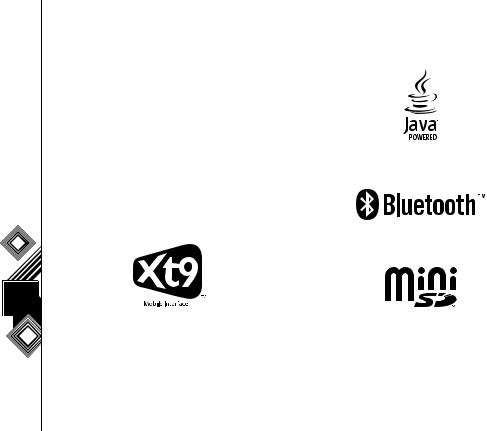
Licenses |
Licenses |
|
or more of the following United States Patents and/ |
||
|
Licensed by QUALCOMM Incorporated under one |
|
|
or their counterparts in other nations: |
|
|
4,901,307 |
5,504,773 5,109,390 5,535,239 |
|
5,267,262 |
5,600,754 5,416,797 5,778,338 |
|
5,490,165 |
5,101,501 5,511,073 5,267,261 |
|
5,568,483 |
5,414,796 5,659,569 5,056,109 |
|
5,506,865 |
5,228,054 5,544,196 5,337,338 |
|
5,657,420 |
5,710,784 |
|
XT9 is trademark of Tegic Communications, Inc. |
|
|
Tegic Communications, an AOL Company. |
|
10 |
|
|
Java™ and all Java-based marks are trademarks or registered trademarks of Sun Microsystems, Inc.
Bluetooth™ is a trademark of Bluetooth SIG, Inc.USA.
This miniSDTM logo is a Trademark.
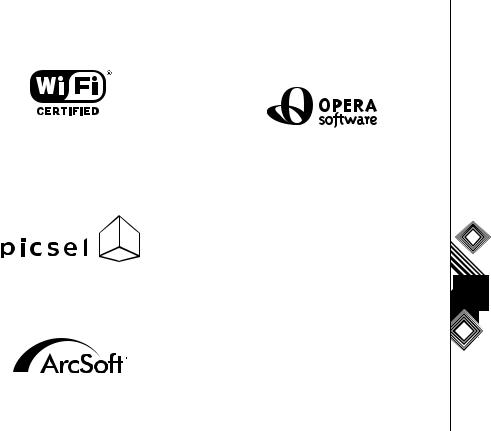
Licenses
Wi-Fi CERTIFIED is a Certification Mark of the Wi-Fi Alliance
Picsel, Picsel Powered, Picsel Viewer, Picsel File Viewer, Picsel Document Viewer, Picsel PDF Viewer and the Picsel cube logo are trademarks or registered trademarks of Picsel Technologies and/ or its affiliates.
ArcSoft and the ArcSoft logo are registered trademarks of ArcSoft, Inc. in the United States, P. R. China, EU, and Japan.
Opera is a trademark or registered trademark of Opera Software ASA.
Read more about Opera at http://www.opera.com/.
Licenses |
11 |
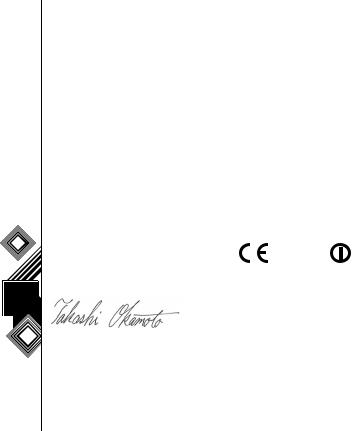
conformity |
Declaration of conformity |
our sole responsibility that this product (Portégé G900, Type (Model) Name RG4 - E02) is in conformity with |
|
|
We, Toshiba Information Systems UK (Ltd), Mobile Communications Division, of |
|
Toshiba Court, Weybridge Business Park, Addlestone Road, Weybridge, KT15 2UL declare under |
of |
the following standards and/or other normative documents: |
Declaration |
3GPP TS 51.010-1, 3GPP TS 34.121, EN 301 489-1, EN 301 489-7, EN 301-489-24, EN 300 328, |
|
EN 301 489-17, EN 60950 and EN 50360 |
|
We hereby declare that all essential radio test suites, EMC & safety requirements have been carried out |
|
and that the above named product is in conformity to all the essential requirements of Directive 1999/5/EC. |
|
The conformity assessment procedure referred to in Article 10(5) and detailed in Annex IV of Directive |
|
1999/5/EC has been followed with the involvement of the following Notified Body(ies): |
|
Cetecom GmbH, Im Teelbuch 122, 45219 Essen, Germany |
|
0682 |
|
11 April 2007 |
|
Takashi Okamoto |
|
Deputy Managing Director of TIU |
|
General Manager Mobile Communications Division |
12 |
|

Health and safety
General
•Always use your Toshiba phone in the intended manner. Incorrect usage may affect performance. Only qualified service personnel should install or repair the phone and its accessories.
•To avoid permanent damage to your Toshiba phone, use only Toshiba approved batteries and accessories.
•The bundled battery and AC adapter are only for use with your Toshiba phone. Do not use this battery or AC adapter with any other device as this may cause permanent damage to the device, battery and AC adapter.
•Before connecting your Toshiba phone to another device, read the supporting documentation to confirm that the other device is compatible.
•When making emergency calls from your Toshiba phone, ensure that the phone is switched on and in service.
•When your Toshiba phone is used for extended periods of time, especially in high temperature conditions, the phone surface could become hot. Please use caution when touching the phone
under such conditions.
•When using ear buds or other headphones, be careful not to listen at excessive volumes. Listening to very loud sound levels may lead to hearing loss. Also, listening through the ear buds or headphones for prolonged periods of time, even at normal sound levels, may lead to hearing loss. You should consult your doctor for more information on proper use of ear buds or headphones.
•It is recommended that pregnant and young women take precautions while in a call and keep the phone at a distance from their lower abdomen. For this situation, use of a hands free kit is recommended.
Health and safety |
13 |

safety |
Health and safety |
|
Operating environment |
||
and |
||
• Do not handle your Toshiba phone while driving |
||
Health |
or when operating machinery. If you must |
|
free device, make sure the phone is securely |
||
|
handle the phone while driving, park the vehicle |
|
|
before conversing. If using an integrated hands |
|
|
placed in its holder. |
|
|
• Switch your Toshiba phone off if you are |
|
|
entering a hospital or health care facilities. |
|
|
Medical equipment may be affected by phone |
|
|
usage. Always follow building regulations |
|
|
governing phone usage. |
|
|
• Switch your Toshiba phone off when travelling on |
|
|
an aircraft. The phone signal may interfere with |
|
|
the systems in the aircraft. You are legally bound |
|
|
to comply with this recommendation. |
|
|
• Switch your Toshiba phone off in any facility |
|
|
where posted notices prohibit phone usage. |
|
|
• Do not use your Toshiba phone when refuelling. |
|
|
You should keep the phone away from fuel and |
|
|
chemicals. |
|
|
• Switch your Toshiba phone off when blasting is |
|
|
in progress and observe all provided guidelines |
|
|
and regulations. |
|
14 |
|
•Switch your Toshiba phone off in areas with potentially explosive atmospheres. For example, fuel storage areas and spray paint facilities.
•Switch your Toshiba phone off when outdoors during an electrical storm.
•Only qualified personnel should install the device in a vehicle. Faulty installation or service may be dangerous and may invalidate any warranty. For more information, consult your vehicle manufacturer or representative.

Health and safety
Electronic devices
•If you wear a pacemaker, or are in the company of someone who does, you should be aware that there is a small risk of mobile phone usage interfering with the operation of the pacemaker. You should contact your doctor, or the manufacturer of the pacemaker, for more information.
•Mobile phone usage may interfere with some hearing aids. If this happens you should contact your service provider or doctor.
•Mobile phone usage may interfere with the functionality of inadequately shielded medical devices. Consult a physician or the manufacturer of the device to ensure safe procedures are used.
•Mobile phone usage may interfere with the functionality of any inadequately shielded electronic system in a motor vehicle. Examples include airbags and fuel injection. You should contact the manufacturer of the vehicle to ensure that the electronic system is properly shielded.
Battery safety |
safety |
|
and |
||
Your Toshiba phone is powered by a rechargeable |
||
battery. The full performance of a new battery is |
Health |
|
and discharged hundreds of times but it will |
||
achieved only after two or three complete charge |
|
|
and discharge cycles. The battery can be charged |
|
|
eventually wear out. When the talk and standby |
|
|
times are noticeably shorter than normal, it is |
|
|
recommended that you buy a new battery. |
|
|
• A new battery, or one that has not been used for |
|
|
a long time, could have reduced capacity during |
|
|
initial use. |
|
|
• The battery can only be charged in temperatures |
|
|
between +5 °C (+41 °F) and +35°C (+95 °F). |
|
|
• Only use batteries approved by Toshiba and only |
|
|
recharge the battery with the recommended |
|
|
charger supplied by Toshiba. |
|
|
• When the charger is not in use, disconnect it from |
|
|
the power source. |
|
|
• Do not leave the battery connected to the |
|
|
charger and power source for longer than |
|
|
necessary as overcharging will shorten the |
|
|
lifespan of the battery. |
|
|
|
15 |

safety |
Health and safety |
||
• |
Do not short-circuit the battery. Accidental short- |
||
and |
|||
|
circuiting can occur when a metallic object |
||
|
causes a direct connection between the + and - |
||
Health |
|
terminals of the battery. |
|
• Do not leave the battery in areas of extreme cold |
|||
|
|
or heat as this will affect the performance of the |
|
|
|
battery. Areas of extreme cold include a |
|
|
|
refrigerator, and areas of extreme heat include a |
|
|
• |
car exposed to direct sunlight. |
|
|
Do not dispose of the battery in a fire. |
||
|
• Do not dispose of the battery in an ordinary bin. |
||
|
|
The battery contains toxic chemicals and must |
|
|
|
be disposed appropriately. Contact your local |
|
|
|
authorities for more information. |
|
16 |
|
|
|
AC adapter and cable safety
•Do not use a damaged or worn AC adapter or cable. The use of a damaged or worn AC adapter or cable could result in electric shock, burns or fire. Contact an authorised Toshiba service provider immediately to obtain suitable replacements.
•Do not bend or twist the AC cable.
•Do not pull on the AC cable in order to remove the plug from a socket.
•Do grasp the plug directly when unplugging the AC cable to avoid causing any damage to the cable.
•Do not place heavy objects on the AC adapter or cable.

Health and safety
Emergency calls
Calls cannot be made to emergency services while data communication is being performed within a GSM area. If the system mode is set to UMTS Only or GSM Only, calls cannot be made to emergency services if the selected network is unavailable. Also, calls may not be able to be made to emergency services depending on the network services of some service providers.
IMPORTANT: You can still make calls to emergency services when the SIM card is not inserted, the SIM card is locked, the phone lock is set, Phone is Off, Fixed Dialing is set, or Call Barring is set.
There is no guarantee that a connection can be established in all countries and areas because operation of your phone differs depending on the wireless network, wireless signal and your setting status. Do not rely solely on your mobile phone when you need to make emergency calls.
Wireless LAN security |
safety |
|
and |
||
It is possible for an outside party to easily gain |
||
unlawful access to your Toshiba phone via Wireless |
Health |
|
the risk of unlawful access, wiretapping, and loss or |
||
LAN if the security function is not used. |
|
|
Without this security, your Toshiba phone carries |
|
|
destruction of data. |
|
|
You should set up your Toshiba phone to use the |
|
|
authentication and encryption features (WEP, WPA) |
|
|
in order to prevent such access. |
|
|
When using a public Wireless LAN access point, |
|
|
your Toshiba phone should be protected from |
|
|
unlawful access by the Windows firewall of |
|
|
Windows Security Centre and the anti-virus |
|
|
software within the firewall feature. |
|
|
Bluetooth security |
|
|
Although your Toshiba phone has security features |
|
|
compliant with the Bluetooth standard specification, |
|
|
this security might not work properly when using |
|
|
your Toshiba phone in a non-secure environment. |
|
|
Take care when using the Bluetooth feature. |
|
|
|
17 |
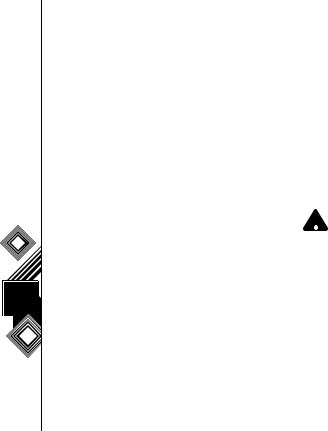
safety |
Health and safety |
|
FCC notice |
||
and |
||
This device complies with Part 15 of the FCC rules. |
||
Health |
Operation is subject to the following two conditions: |
|
(1) This device may not cause harmful interference, |
||
and (2) This device must accept any interference |
||
received, including interference that may cause |
||
|
undesired operation. |
|
|
Changes or modifications not expressly approved |
|
|
by the party responsible for compliance could void |
|
|
the user’s authority to operate the equipment. |
|
|
Information to user |
|
|
This equipment has been tested and found to |
|
|
comply with the limits of a Class B digital device, |
|
|
pursuant to Part 15 of the FCC Rules. These limits |
|
|
are designed to provide reasonable protection |
|
|
against harmful interference in a residential |
|
|
installation. This equipment generates, uses and |
|
|
can radiate radio frequency energy and, if not |
|
|
installed and used in accordance with the |
|
|
instructions, may cause harmful interference to |
|
|
radio communications. However, there is no |
|
|
guarantee that interference will not occur in a |
|
|
particular installation; if this equipment does cause |
|
18 |
harmful interference to radio or television reception, |
|
|
which can be determined by turning the equipment off and on, the user is encouraged to try to correct the interference by one or more of the following measures:
1.Reorient/relocate the receiving aerial.
2.Increase the separation between the equipment and receiver.
3.Connect the equipment into an outlet on a circuit different from the outlet the receiver is currently connected.
4.Consult the dealer or an experienced radio/TV technician for help.
WARNING: Changes or modifications not
!expressly approved by the manufacturer responsible for compliance could void the user’s authority to operate the equipment.

Health and safety
FCC RF exposure information
Your Toshiba phone is a radio transmitter and receiver. It is designed and manufactured not to exceed the emission limits for exposure to radio frequency (RF) energy set by the Federal Communications Commission of the U.S. Government.
The guidelines are based on standards that were developed by independent scientific organisations through periodic and thorough evaluation of scientific studies. The standards include a substantial safety margin designed to assure the safety of all persons, regardless of age and health.
The exposure standard for wireless handsets employs a unit of measurement known as the Specific Absorption Rate, or SAR. The SAR limit set by the FCC is 1.6W/kg. The tests are performed in positions and locations (e.g., at the ear and worn on the body) as required by the FCC for each model. The SAR value for this model handset when tested for use at the ear is 0.497W/kg and when worn on the body, as described in this user guide, is 1.178W/kg.
Body-worn operation |
safety |
|
and |
||
This phone was tested for typical body-worn |
||
operations with the back of the phone kept at a |
Health |
|
distance of 1.5cm from the body. To maintain |
||
compliance with FCC RF exposure requirements, |
||
use accessories that maintain a 1.5cm separation |
|
|
distance between your body and the back of the |
|
|
phone. The use of belt clips, holsters and similar |
|
|
accessories should not contain metallic |
|
|
components. The use of accessories that do not |
|
|
satisfy these requirements may not comply with |
|
|
FCC RF exposure requirements, and should be |
|
|
avoided. |
|
|
The FCC has granted an Equipment Authorization |
|
|
for this model handset with all reported SAR levels |
|
|
evaluated as in compliance with the FCC RF |
|
|
emission guidelines. SAR information on this model |
|
|
handset is on file with the FCC and can be found |
|
|
under the Display Grant section of http:// |
|
|
www.fcc.gov/oet/fccid after searching on FCC ID |
|
|
SP2-RG4-E02. |
|
|
Additional information on Specific Absorption Rates |
|
|
(SAR) can be found on the Cellular |
|
|
Telecommunications & Internet Association (CTIA) |
|
|
website at http://www.phonefacts.net. |
|
|
|
19 |

safety |
Health and safety |
|
European RF Exposure |
||
and |
||
Information |
||
Health |
Your Toshiba phone is a radio transmitter and |
|
receiver. It is designed not to exceed the limits for |
||
|
exposure to radio waves recommended by |
|
|
international guidelines. These guidelines were |
|
|
developed by the independent scientific |
|
|
organisation ICNIRP and include safety margins |
|
|
designed to assure the protection of all persons, |
|
|
regardless of age and health. |
|
|
The guidelines use a unit of measurement known as |
|
|
the Specific Absorption Rate, or SAR. The SAR limit |
|
|
for mobile devices is 2 W/kg and the SAR value for |
|
|
this device when tested at the ear was 0.443W/kg*. |
|
|
As mobile devices offer a range of functions, they |
|
|
can be used in other positions, such as on the body |
|
|
as described in this user’s guide**. In this case, the |
|
|
tested SAR value is 1.154W/kg. |
|
|
As SAR is measured utilising the device’s highest |
|
|
transmitting power, the actual SAR of this device |
|
|
while operating is typically below that indicated |
|
|
above. This is due to automatic changes to the |
|
|
power level of the device to ensure it only uses the |
|
|
minimum level required to reach the network. |
|
20 |
|
The World Health Organization has stated that present scientific information does not indicate the need for any special precautions for the use of mobile devices. They state that if you want to reduce your exposure then you can do so by limiting the length of calls or using a ‘hands-free’ device to keep the mobile phone away from the head and body. Additional Information can be found on the website of the World Health Organization (http:// www.who.int/emf).
*The tests are carried out in accordance with international guidelines for testing.
**Please see the <FCC RF Exposure Information> section about body worn operations.

Health and safety |
safety |
|
The following Information is only for EU-Member |
||
Health and |
||
States: |
||
|
||
The use of the above symbol indicates that this |
|
|
product may not be treated as household waste. By |
|
|
ensuring this product is disposed of correctly, you |
|
|
will help prevent potential negative consequences |
|
|
for the environment and human health, which could |
|
|
otherwise be caused by inappropriate waste |
|
|
handling of this product. For more detailed |
|
|
information about recycling of this product, please |
|
|
contact your local city office, your household waste |
|
|
disposal service or the shop where you purchased |
|
|
the product |
|
|
|
21 |

maintenance |
Care and maintenance |
|
Care and maintenance |
||
|
||
|
You can greatly enhance the life span of your |
|
|
Toshiba phone, and the parts and accessories, by |
|
and |
following the suggestions below. |
|
TIP: Maintaining your Toshiba phone, and the |
||
parts and accessories, in a good condition will |
||
Care |
help you fulfil the warranty obligations. |
|
• Keep your Toshiba phone, and all the parts and |
||
|
accessories, out of the reach of small children |
|
|
and pets. |
|
|
• Keep your Toshiba phone dry, as moisture of any |
|
|
kind can contain minerals that will corrode the |
|
|
electronic circuits. The manufacturer's warranty |
|
|
may become invalid if the phone or battery were |
|
|
to get wet due to misuse. |
|
|
• Do not use or store your Toshiba phone in dusty |
|
|
or dirty locations as the moving parts of the |
|
|
phone can be damaged. |
|
|
• Do not use or store your Toshiba phone in hot |
|
|
areas. High temperatures will shorten the life |
|
|
span of the phone, damage the battery, and |
|
|
warp/melt internal circuits. |
|
|
• Do not store your Toshiba phone in cold areas. A |
|
|
big difference between room temperature and |
|
22 |
|
the temperature in the phone can cause condensation to form inside the phone, damaging the electronic circuits.
•Do not keep your Toshiba phone in, or near, heat sources such as a radiator or microwave oven - this can cause the battery inside the phone to overheat and explode.
•Do not open your Toshiba phone unless absolutely necessary.
•Do not mishandle or abuse your Toshiba phone. Dropping the phone, or knocking or shaking it, can damage the internal circuits.
•Do not use harsh chemicals, strong detergents, or cleaning solvents to clean your Toshiba phone. Use a soft, clean, dry, lint-free cloth to clean the phone.
•Do not use water to clean the Touch screen.
•Keep the Touch screen and tip of the Stylus clean to avoid permanent damage.
•For touch screen input, use only the included stylus or your finger. Use of other objects can damage the input panel and will void the warranty.
•It is recommended that you use the bundled stylus when pressing the Reset button.
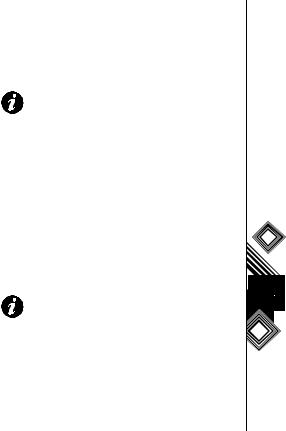
Care and maintenace
•If the tip of the stylus is damaged, do not use it. If you operate the Touch screen with a damaged stylus, the Touch screen may be damaged.
When the stylus is damaged, please purchase a new one.
•Do not tap hard on the Touch screen, as this may cause permanent damage to the screen.
•Do not apply paint or other such substances to your Toshiba phone.
•If your Toshiba phone, or any of the accessories, are not working as they should, please consult your dealer, who can provide you with the expert assistance you require.
•Do not use excessive volume levels when using headphones.
•If your Toshiba phone has a flash unit, do not operate the flash too close to a person’s eyes - this may cause damage to their eyes.
•Interference may affect the performance of your Toshiba phone. This is normal and the phone should operate as usual once you move away from the source of the interference.
•Do not attempt to disassemble your Toshiba phone. Only Toshiba authorised personnel should service the phone.
Restarting your Toshiba phone |
maintenance |
|
|
If you have any problems, such as the phone |
|
freezing, press and hold the Power key. |
|
IMPORTANT: If you restart your Toshiba |
and |
phone while a program is running, data that |
|
you have not saved will be lost. |
|
Resetting your Toshiba phone |
Care |
If, after you have restarted your Toshiba phone, |
|
there is still a problem, or if you are having difficulty |
|
restarting the phone, press the Reset button. |
|
If the problem still remains: |
|
1. Remove the battery (refer to Getting started |
|
section for instructions). |
|
2. Re-insert the battery and turn your Toshiba |
|
phone on (refer to Getting started section for |
|
instructions). |
|
IMPORTANT: If you reset your Toshiba |
|
phone, there is a possibility that saved and |
|
unsaved data will be lost. |
|
|
23 |

maintenance |
Care and maintenance |
You should only use this procedure as a last resort. |
|
|
Reinitialising your Toshiba |
|
phone |
and |
If you are experiencing a problem with an |
application, it is most likely a result of a conflict |
|
Care |
between installed programs. We recommend un- |
installing the most recently added program first. |
|
Also verify that the program is designed to be run on |
|
|
your Toshiba phone by comparing the requirements |
|
to the information provided with your phone - tap |
|
Start > Settings > System > About to view this |
|
information. |
|
To reinitialise your Toshiba phone, refer to the |
|
Master Clear subsection in Settings. |
|
We recommend that you back up all of your data |
|
before reinitialising your Toshiba phone. |
|
IMPORTANT: It is recommended that you |
|
frequently back up all of your data on your |
|
Toshiba phone. |
24 |
|

Getting started |
started |
|
Unpacking |
||
Please ensure that the contents of your sales pack |
Getting |
|
include: |
|
|
• Your Toshiba phone with stylus |
|
|
• |
AC adapter |
|
• |
AC cable |
|
• |
Battery pack |
|
• |
USB cable |
|
• |
USB Host cable |
|
• |
Earphones |
|
• |
Quick start guide |
|
• |
CD (Getting Started) |
|
• CD (User Guide and PC Applications) |
|
|
|
|
25 |

started |
Getting started |
Phone layout and functions |
|
Getting |
|
26 |
|
1.Earpiece
2.Front camera
3.Touch screen
4.Side key - adjusts the volume.
5.Program button 3 - initially set to Camera.
6.OK key - confirms data entries, and exits the current program. Press and hold this key to change ringer settings (On/Vibrate/Off).
7.Program button 2 - initially set to Messaging.
8.End key - ends calls/operations and returns to Today screen.
9.Stylus
10.Cable and phone charging connector
11.Navigation key / Action key - moves the cursor up, down, left or right, confirms operations and accesses shortcuts. The Action key is used to open the selected operation.
12.Microphone
13.Handstrap hole
14.Send key - launches the phone pad mode. Makes and answers calls.
15.Program button 1 - initially set to Contacts.
16.Start key - activates the Start menu.
17.Left softkey and Right softkey - perform operations indicated on the touch screen.
18.miniSD card slot
19.Headset connector
20.Program button 4 - initially set to Internet access.
21.Power LED - bi-colour LED Power indicator, battery charging status.
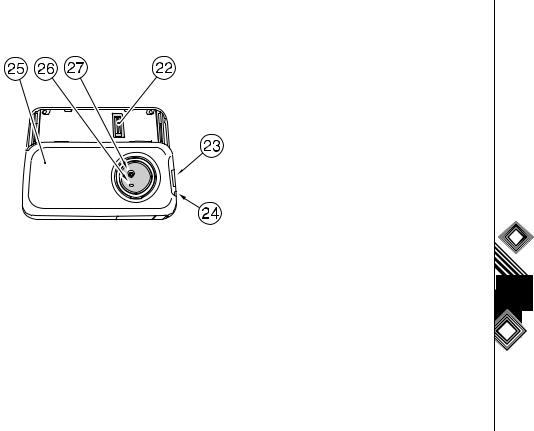
Getting started
22. Fingerprint sensor
23. Cover lock button - locks and unlocks battery cover.
24. Power key - press and hold to turn power on/off. Press to enter sleep mode, and press and hold to wake up from sleep mode.
25. Battery cover
26. Camera light
27. Rear camera
Getting started |
27 |
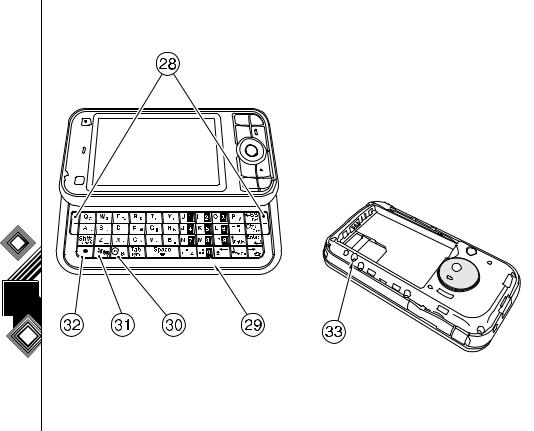
Getting started |
Getting started |
|
|
28 |
|
28.Left softkey and Right softkey - perform operations indicated on the touch screen.
29.Keyboard - for entering phone numbers and characters.
30.OK key (first level) / Bluetooth (second level)
31.Start key (first level) / Wireless LAN (second level)
32.Function key - used to access the second level key functions by pressing this key at the same time as the key with the required second level function.
33.Reset button
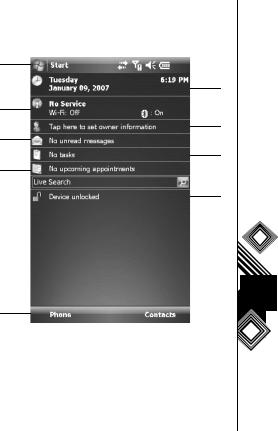
Getting started
Today screen
You can access the Home screen from any menu by pressing the End key. Important information such as date, time, status indicators, appointments and profile are displayed on the Today screen. You can open a program directly by selecting the relevant icon and pressing the Action key.
1.Title bar
2.Displays time and date.
3.Displays the name of your wireless service provider, and Wi-Fi and Bluetooth connectivity status.
4.Displays owner information.
5.Displays unread messages.
6.Display tasks.
7.Displays appointments.
8.Displays lock status.
9.Command bar. These buttons are dynamic, and depend on previous activity on the phone.
1
2
3
4
5
6
7
8
9
Getting started |
29 |
